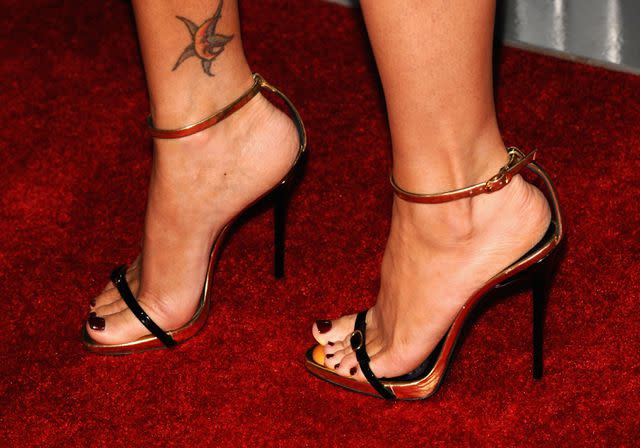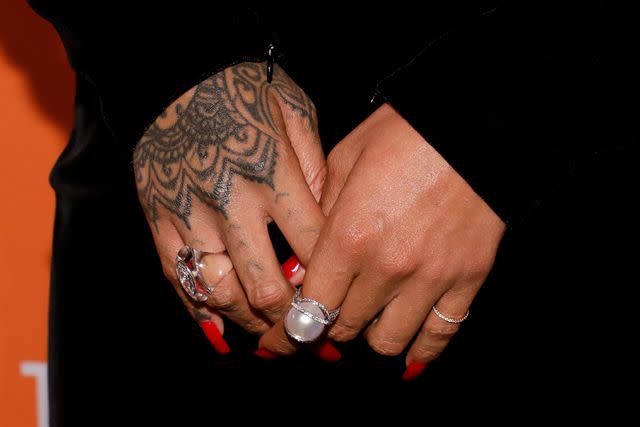How to Treat Fading Tattoos — And Keep Future Ones as Fresh as Possible

Getty Images
Dealing with a faded tattoo probably isn't a part of your inky daydreams — but it's certainly a reality of the process.
"All tattoos fade; that is to be expected," says tattoo artist Melody Mitchell. That said, consideration and attention to healing and aftercare can help to ensure that your body art stays as vibrant as possible. Before you commit (and we mean forever) to your favorite tattoo trend, read on to learn how to keep your new tattoo looking fresh and vivid.
The Tattoo Healing Timeline
Understanding your tattoo's healing timeline is the first step in caring for your permanent ink — and avoiding fading as much as possible.
"Immediately after tattooing and before the first layer of skin heals over, you have a fresh tattoo. This is the sharpest and most saturated your tattoo will ever look," says tattoo artist Lindsey Strong. This is also when your skin is the most vulnerable to infection and other sanitary issues, which is why following your artist's aftercare instructions is of paramount importance.
"After a few days of healing, the outermost layer of skin 'closes' over the tattoo, giving it a few different looks ranging from hard and shiny with tiny waves or ridges, scaly or scabby, raised, or red and irritated," says Strong. "Until this top layer of skin has fully turned over (about four weeks if you’re not using a medical adhesive bandage), your tattoo is still vulnerable, and any scab that you pick can re-open the skin." Picking scabs can also lead to a permanent loss of color (aka fading), so when in doubt, avoid touching your tattoo except to wash and moisturize as prescribed.
According to Strong, after eight months of healing, your tattoo will appear as it will for most of your life. "It will fade and spread over time, but for the most part, anything that is going to heal out will have healed out," she says. After this, your tattoo will very slowly fade and spread, and pigment will be carried to your lymph nodes throughout the rest of your life!"
Causes of Tattoo Fading

Getty Images
Though a certain amount of tattoo fading is natural, the main causes of excessive fallout come down to poor execution of art and aftercare. "The biggest culprit for a too-fast fading tattoo is definitely a bad tattoo artist," says Mitchell. "If the color falls out of your tattoo completely or becomes very blotchy with pieces of skin showing through, then that is the fault of the artist." Should ink go too deep, tattoos can spread and blur; if not deep enough (inked into the epidermis rather than the dermis), color can dissipate and disappear.
Improper care of your new tattoo can also sap color and definition. Too much time outside, particularly sans sunscreen, can lead to unwanted peeling and fading, while soaking in hot water can cause the ink to seep from your skin, resulting in a blurred design. "Some people who have extreme eczema or psoriasis will have difficulty with how their tattoos heal," adds Mitchell, who notes that touchup sessions can be essential for this set.
Even after the initial healing stage, the sun is still something to consider regarding lasting saturation. "The sun breaks down the pigment, even under your skin," says Strong. "The lightest colors will fade the fastest, but all ink can fade fast from general sun exposure."
How to Prevent Tattoo Fading
Avoiding a faded tattoo starts at the salon. "Do your research and get quality work from quality artists," says Mitchell.
Choosing your design wisely can also help protect you from a fade-out — and Strong notes that poorly executed designs tend to reveal themselves at the eight-month mark. "This is when tattoos that look like pencil drawings (single needle) or a dime-sized Monet start to show their true colors (pun intended)," she says. "They'll typically look fully erased (in the case of the former) or totally smudged and illegible, more like a bruise than a lily pond."
Once your skin is inked, following immediate aftercare instructions will start your healing journey off on a good foot. Avoid immediate and prolonged exposure to water and sun, and remember that SPF (minimum SPF 30, per the American Academy of Dermatology Association) is your tattoo's best friend. Regular exfoliation of your healed tattoo can also slough off dead and dull skin and help promote skin turnover, allowing your ink to appear sharper and fresher.
Finally, the same considerations that benefit the rest of your face and body will also help your tattoo. "General skin care will always give you the best results not only for your tattoos but for the health of your skin, which is the starting point," says Mitchell. "Stay hydrated, eat healthy foods, and get some sun (but not too much)."
How to Care for a Faded Tattoo

Getty Images
Bad news: Barring a new design, there's not a ton to be done to renew a tattoo. "Despite some pretty sketchy advertising, there is basically nothing to 'reinvigorate' a tattoo," says Strong. "You can put oil on top of the skin to make the top layer of the dermis more transparent, which makes your tattoos appear brighter and fresher, but there is nothing happening beneath the skin to change the actual tattoo. This is why I say fighting the aging of a tattoo is just as futile as fighting the aging of our skin. You can do a little, but you can’t do a lot!"
In terms of touch-ups (which can be carried off more than twenty years post initial inking) outlining existing tattoos can help the original design to appear sharper. Some artists prefer to cover faded art or to incorporate it into an entirely new design. Some, however, do neither. "A lot of really good tattoo artists don’t like to clean up other people's dirty work, so it’s best to start off on the right foot and get your tattoos done by a good tattoo artist," says Mitchell. "But if it’s too late for that there are definitely still artists out there that will help you out. You just have to do your homework and be diligent about finding the right artist to work with."
For more InStyle news, make sure to sign up for our newsletter!
Read the original article on InStyle.


